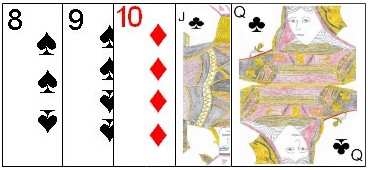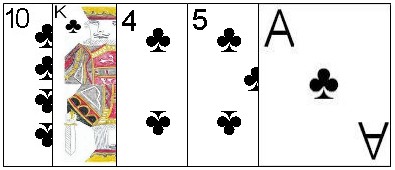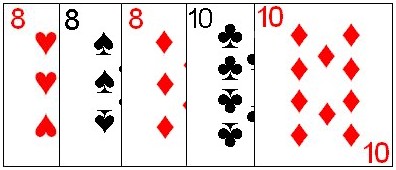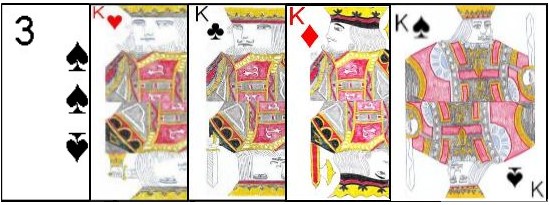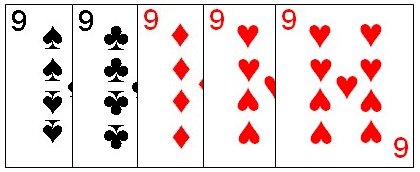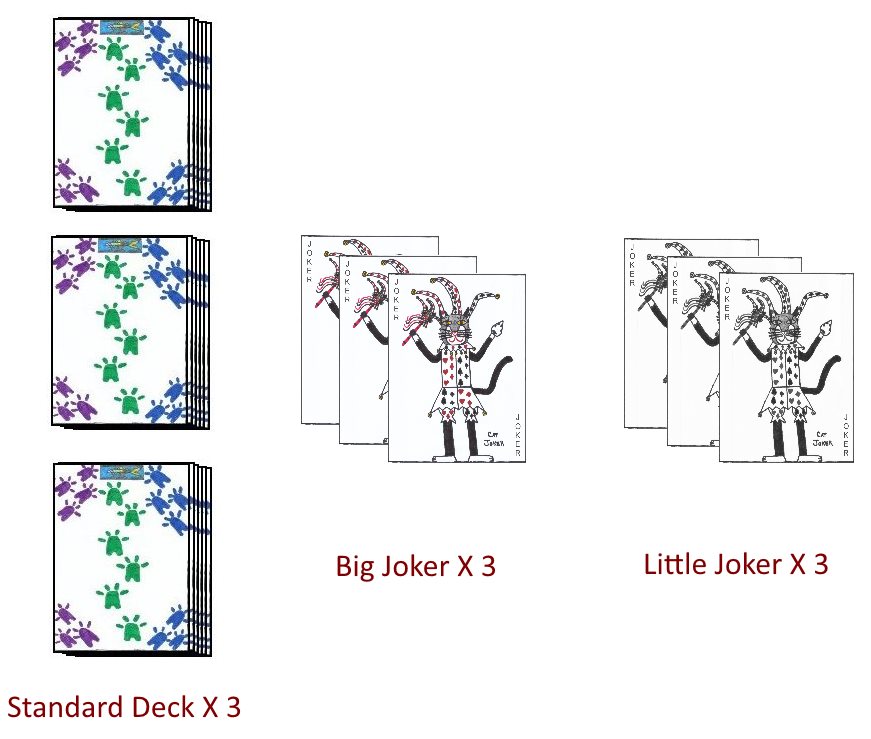 Wild Escape is a 6 player game consisting of two partnerships of three players each. The games uses three standard 52 card decks, including two Jokers per deck, all shuffled together to make one large deck. The two Jokers added from each pack should be easily distinguished from each other, one being the Large (or Big) Joker and the other the Small Joker. Thus, the total deck should include three Large Jokers and three Small Jokers. The ranking of the cards in the game is as follows (from highest to lowest); Big Joker, Small Joker, Ace, King, Queen, Jack, 10, 9, 8, 7, 6, 5, 4, 3, 2. However, this ranking will be modified by the current Trump card selected for the hand.
Wild Escape is a 6 player game consisting of two partnerships of three players each. The games uses three standard 52 card decks, including two Jokers per deck, all shuffled together to make one large deck. The two Jokers added from each pack should be easily distinguished from each other, one being the Large (or Big) Joker and the other the Small Joker. Thus, the total deck should include three Large Jokers and three Small Jokers. The ranking of the cards in the game is as follows (from highest to lowest); Big Joker, Small Joker, Ace, King, Queen, Jack, 10, 9, 8, 7, 6, 5, 4, 3, 2. However, this ranking will be modified by the current Trump card selected for the hand.
Determination of partnerships can be performed in a number of ways, with a common method being for each player to draw a card from the shuffled pack. The players drawing the three highest cards playing as partners against the three players drawing the three lowest cards. The players should sit at the table such that each player is seated in such a way that he has a member of the opposing partnership to his right and left. Thus, this will ensure that during gameplay a turn alternates between a member of each team. The player drawing the highest card of all should also be set as the Offense Leader for the first round. If multiple players tie for drawing of a card of the highest rank, these players should each discard that card and draw a replacement card, continuing to do so until drawing cards of a unique denomination.
After the partnerships have been determined and the players seated, the player to the immediate right of the first Offense Leader should reshuffle the cards offering it to the player at his right. After the cut, the dealer begins dealing the cards one-by-one and face-down in a clockwise direction around the table. He continues dealing until every player (including himself) has 27 total cards. The Offense Leader has the first turn.
Advancing the Level: The objective of the Offense Team is to increase their current level. While the goal of the opposing team is to prevent the Offense Team from raising their level such that the opposing team can take over the role of the Offense Team for the next hand. At any point in the game, one of the partnerships is considered the Offense Team and the other team the Defense team. Only the Offense Team can raise the level on a particular round. Each team starts with a Level or Ranking. At the start of the game, both teams start at the level or rank of 2. Each time the current Offense Team manages to raise their level, they are entitled to raise their current level by one. Thus, the first team to raise their ranking during the game will increase their current level to 3. The rankings go as follows (from low to high): 2, 3, 4, 5, 6, 7, 8, 9, 10, Jack, Queen, King, Ace. The first team to reach a specific ranking level is declared the winner of the game. Another feature of the current level of a team, is that the current level or rank of the current Offense Team is considered a special Trump rank for the hand. This causes the cards of the trump rank to temporarily have an increase in the value of that card during the current hand. Thus, for instance, if the current rank of the Offense team were 8, the ranking of the cards on this hand would be as follows: Big Joker, Little Joker, 8, Ace, King, Queen, Jack, 10, 9, 7, 6, 5, 4, 3, 2.
The game is played similarly to other shedding type card games in that the players attempt to deplete their hand of cards as fast as possible. The Offense Leader has the first turn of each hand, with the turns then continuing in a clockwise rotation around the table from player to player. This player may make any legal play on his turn. The legal plays are as follows:
| Card Combination | Description | Example | |||||||||||||||||
|---|---|---|---|---|---|---|---|---|---|---|---|---|---|---|---|---|---|---|---|
| Single Card | This consists of any one single card played to the table. A higher ranked single card will beat a lower ranked single card. | 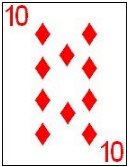 | |||||||||||||||||
| Two Card combination | A two card combination consists of two card of the exact same rank (suit is irrelevant). To beat another two card combination, the rank of the two cards comprising the combination must be higher that the current high ranked combination played on the table. |  | |||||||||||||||||
| Three Card combination (Three of a Kind) | A three card combination consists of three cards of the exact same rank (suit is irrelevant). A three card combination can be beaten by a three card combination consisting of a higher ranked three of a kind. | 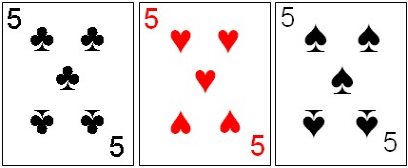 | |||||||||||||||||
| Five Card combination | A five card combination consists of a specific combination of five cards in the hand. There are multiple types of five card combinations possible, with different ranking. The following chart shows the ranking (from lowest to highest) of a five card combination:
A five card combination can be beat by either a higher ranked combination of the same type, or any five card combination of another type. |
|
In addition to the Jokers being considered a rank themselves, a Joker is also considered a wild card and can be used, in a play, to represent any other, lower ranked card in a valid combination. When used in this way the Joker takes on the value of the card it is replacing. If there is any doubt as to the value the Joker is replacing the player should state the card the Joker is intended to replace in the play. Also note that, if used as an actual Joker, the Big Joker is considered to be of a different rank than a Little Joker.
Thus, after the first play, each subsequent player attempts to play a higher ranking combination consisting of the same number of cards. Thus, if the lead play were a three card combination, each player in turn would attempt to play a higher ranking three card combination. In order to be a valid play, a player must be able to play a higher ranked combination. An equally ranked combination may not be played. If a player is unable to play a higher ranked combination (or chooses not to for any reason) he simply passes, missing his turn. Once a valid play is followed by five consecutive passes, the last player to play on this last round is entitled to start a new set of plays using any combination of cards from his hand of his choice. When a player manages to play his last card from his hand during his turn, he is said to have "escaped". He, of course, must pass on each subsequent turn on the same hand.
A player, during the hand may ask any other player in the game the number of cards he currently has remaining in his hand. That player must answer truthfully unless he has 10 or more cards, in which case he may simply refuse to answer.
The hand continues until all members of one team manage to escape. The outcome of the hand is directly determined by several factors, mainly which team was the first to have every member escape and which was the first player to escape.
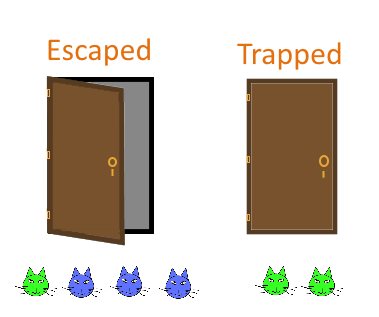
- If all members of the Offense team manage to escape before all members of the Defense team and a member of the Offense team escapes first : In this case, the Offense team is said to have won the round. They are entitled to increase the rank by one. The same team remains the Offense team for the next hand, and the first player to escape is the Offense Leader for the next hand. In addition, any players remaining trapped must provide a tribute in cards during the next hand (see below).
- If all members of the Defense team manage to escape before all members of the Offense team but a member of the Offense team is the first to escape: The hand is considered a Draw. No team increases rank, the Offense team remains the Offense team for the next hand and the first player to have escaped is set as the Offense Leader on the next hand. No tribute is required for trapped players.
- If all members of the Offense team manage to escape before all members of the Defense team escape, however a member of the Defender team escapes first: The hand is a draw. No team increases in level. The Defense team on this round becomes the Offense team on the next round. The first player to escape becomes the Offense leader on the next hand. No tribute is required for trapped players.
- If all members of the Defense team manage to escape before all members of the Offense team escape and member of the Defense team is the first to escape: The defending team is said to have won the round. No team increases rank this round, but the former Defense team becomes the Offense team on the next round. The first player to escape becomes the Offense Leader for the next round. The trapped players in this round must provide tribute to the new Offense team in the next hand.
If the high card provided is any Joker, the player receiving the Joker must pass two cards of his choice back to the player who provided the tribute card. That player may then pass back his choice of one of those two cards, or may return another card from his hand which is higher than either of those two cards. If the card passed as Tribute is not a Joker, the player receiving the card simply passes back any card of his choice. All cards passed should be done with the cards face-up so the all other players do not see the cards passed.
If the current Offense Team as at the rank of Ace, and manages to win one more hand they are declared the winner of the hand. For a shorter game, some players prefer to play to a lower rank (for example, the first team to reach rank nine).
